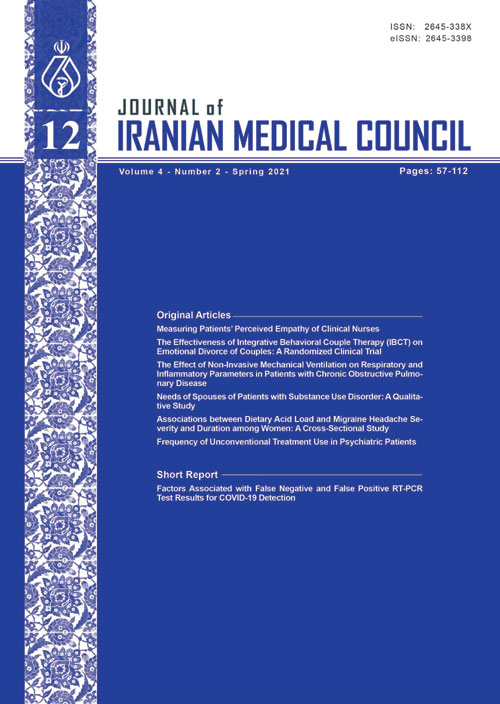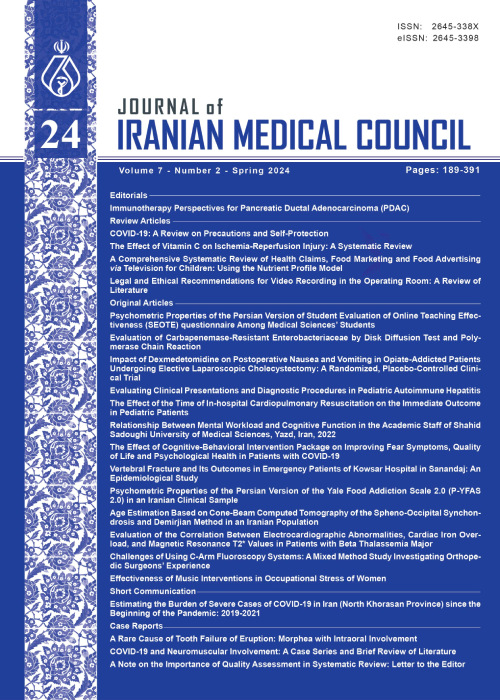فهرست مطالب

Journal of Iranian Medical Council
Volume:4 Issue: 2, Spring 2021
- تاریخ انتشار: 1400/04/20
- تعداد عناوین: 9
-
-
Pages 57-59
Saffron is the dried stigma of a plant named Crocus sativus L. and has been known as the world’s most expensive spice and a widely used medicinal plant. Indeed, saffron is a Persian herb with a history as long as Persian Empire (1). Saffron could be found throughout the world; however, Iran accounts for 90% of the world’s whole saffron and is the origin of the most researches conducted on the potential medical utilities of this expensive spice (2). Beyond the traditional uses of saffron for treating some conditions such as stomachache or impaired digestion, this spice has shown hypolipidemic, hypotensive, anti-inflammatory, antioxidant, neuroendocrine, and neuroprotective effects (3,4). Moreover, it has been exhibited that saffron and its active constituents can increase the reuptake inhibition of dopamine and norepinephrine, antagonize N-methyl-D-aspartate (NMDA) receptors, and agonize Gamma Aminobutyric Acid (GABA) receptors (5). There is mounting evidence proposing psychoprotective properties of saffron in different neurological and psychiatric settings.
-
Pages 60-63
AbstractRituximab (RTX), as a B cell-depleting agent, is indicated in treating several malignancies and autoimmune diseases. The management of patients currently receiving RTX and patients starting the medication raised concerns in the pandemic era. Theoretically, suppressing the immune response at the beginning of coronavirus disease 2019 (COVID-19) enhances viral replication, but it prevents acute respiratory distress syndrome as the disease progresses. This review aims to investigate the results of RTX administration in patients during the pandemic era. There is insufficient evidence to definitively conclude on the safety of RTX during the pandemic. For this purpose, high-quality controlled cohort studies, as well as registry-based studies, would be helpful.
Keywords: Coronavirus, COVID-19, Neoplasms, Pandemics, Rituximab -
Pages 64-71BackgroundEmpathy is the perception of patients’ feelings and experiences; in other words, nurses can understand their patients’ feelings by considering themselves in their position. Empathic relationship in patient care can lead to considerable interpersonal communication and as a result, better outcomes for patient health. Thus, the purpose of this study was to assess patients’ perceived empathy of clinical nurses.MethodsThis cross-sectional study was carried out at teaching hospitals of Zanjan city in 2018 -2019. A sample including 285 inpatients of teaching hospitals in Zanjan city were selected by systematic sampling. To collect data, the Scale of Patient-Perceived Empathy from Nurses (SPPEN) was used. Descriptive statistics (Mean and frequency) and multivariate analyses were applied to describe empathy relationships with personal characteristics.ResultsThe factor analysis on 15 items of SPPEN led to three factors with eigenvalue>1 that totally explained 74.5 percent of the variance. Three dimensions of nurses’ expression, patients’ feedbacks and patients’ expectations were identified as effective factors on patients’ perceived empathy. The mean score of overall SPPEN was at upper intermediate level (m=4.98). The mean score of overall SPPEN and its dimensions in young patients were higher than patients aged 45 years and over. Differences in mean scores of overall SPPEN and its dimensions (Except nurses’ expression) were statistically significant on the base of age characteristics (p <0.05). Furthermore, there were significant differences at mean scores of patients’ feedback and patients’ expectations dimensions on the base of inpatients ward variable (p <0.05). The highest mean score of patients’ feedbacks (5.34±1.05) and patients’ expectations (6.05±1.1) were related to gynecology and surgery wards, respectively.ConclusionThe findings of the present study indicate that inpatients’ perception score of nurses’ empathy was at upper intermediate level. According to the findings, nurses’ empathy and communicative skills must be promoted by establishing training workshops for empathy development.Keywords: Empathy, Inpatients, Nurse-patient relations
-
Pages 72-79BackgroundSome scientists consider emotional divorce as the first step in the divorce process, which means that the marital relationship is declining. Research shows the harmful physical and psychological effects of emotional divorce on couples. The present research was carried out to show the effectiveness of Integrative Behavioral Couple Therapy (IBCT) on emotional divorce among couples.MethodsThis was a quasi-experimental design study with a control group, including a pre-test, post-test and a 45-day follow up. The statistical population of this study was all couples referred to the family therapy clinic of Shahid Beheshti Psychiatric Hospital in Zanjan in 2020. Twenty couples were selected based on a score of eight or higher in a 24-item two-choice questionnaire on emotional divorce which was developed by Guttman in 1998. Next, participants were randomly divided into two groups of experimental and control. The experimental group received 11 weekly sessions of IBCT and each intervention session lasted for 120 minutes and the control group did not receive any intervention. Repeated measures ANOVA was used and data were analyzed by SPSS software V18.ResultsThe results of ANOVA showed that there was a significant difference between the control and experimental groups in the pre-test, post-test and follow-up (p <0.001). Therefore, it can be concluded that IBCT has reduced the emotional divorce of couples in the experimental group.ConclusionResults suggest that IBCT can be used as a treatment of choice for reduction of emotional divorce.Keywords: Couples Therapy, Divorce, Marriage
-
Pages 80-85Background
Chronic Obstructive Pulmonary Disease (COPD) is an airway obstructive disease that is often caused by smoking. The disease is currently the third leading cause of death worldwide. The current therapeutic approach is based on Non-Invasive Ventilation (NIV) therapy, which can reduce mortality, the need for hospitalization in the intensive care unit, and to some extent therapeutic complications. Therefore, this study was performed to determine the effect of non-invasive ventilation along with routine treatments on respiratory markers, inflammation, and clinical status of patients with COPD.
MethodsA total of 30 patients with COPD referred to Masih Daneshvari Hospital were divided into control and intervention groups. In the intervention group, 15 patients underwent non-invasive ventilation in addition to the usual treatments, and in the control group, the patients underwent only the usual treatments. After completing the mMRC (Modified Medical Research Council) questionnaire and evaluating FEV1 (Forced Expiratory Value in one score), 5 ml of blood samples were taken from these patients at the beginning of the study, on the seventh to tenth day, and also in the third month, and the results of this evaluation were compared between the two groups.
ResultsBased on the results of this study, the mMRC score of the intervention group was significantly lower than the control group in the first week (p=0.043) and three months after treatment (p=0.049). However, indices such as FEV1, and IL-8(Interleukin-8) did not change significantly in both groups.
ConclusionThe use of non-invasive mechanical ventilation along with standard treatments can play a relative role in improving patient outcomes.
Keywords: Chronic Obstructive Pulmonary Disease, Interleukin-8, Non-invasive mechanical ventilation -
Pages 86-92Background
The skill of adjusting and regulating the needs and adaptation are the most fundamental abilities of family members. Since substance use related disorders create serious health threats and cost burdens for family, it is important to investigate the needs of spouses of these patients. Regarding the wide spectrum of needs based on previous researches, the psychiatric needs were the focus in this study. By evaluating the needs, the executives of social services can better determine the basic needs of patients and their family members.
MethodsThis is a qualitative study applying a content analysis approach. Based on the objectives of this research, purposeful sampling was done and continued until information saturation. In total, 16 spouses of patients using substance were interviewed. Initial interviews began with guiding questions and the probing questions were applied in the following interviews. Participants’ emotions were coded and codes with similar concepts were placed together in one category and subcategories were created.
ResultsAfter conducting 16 in-depth interviews, 38 initial codes were obtained and categorized into 6 key concepts (Neglecting the reciprocal roles and rights, lack of responsibility, lack of motivation, psychiatric changes due to substance use, feelings of insecurity, and defective communication).
ConclusionThe present study paves the way in better understanding of the needs of the spouses of patients with substance use disorder, and enables the specialists in this area to adjust the treatment according to each individual patient and evaluate emerging patient related issues and challenges as well. Substance dependence, in addition to making problems for the individual and the society, leads to unsatisfied needs of close family members and acquaintances. In other words, treatment will be more effective if each patient is recognized individually, the family is educated, and family-level interventions are provided.
Keywords: adaptation, emotions, Psychological, qualitative research, Substance related disorder -
Pages 93-103Background
Migraine is considered the most common cause of long-term disability in under-50s, which can lead to unbearable pain and neurological dysfunction. Many factors, especially dietary factors, are suggested to trigger migraine headaches. The present study aimed to examine the association between diet-dependent acid load and severity and duration of headaches among migraine patients.
MethodsIn this cross-sectional study, a sample of 266 women (18-45 years) with history of migraine headaches was enrolled. Dietary data was collected by using a validated Food Frequency Questionnaire (FFQ). Then, diet-dependent acid load indices including Potential Renal Acid Load (PRAL) and Net Endogenous Acid Production (NEAP) were calculated for the participants. For all cases, anthropometric measurements and headache duration were assessed. Headache severity was determined by Visual Analog Scale (VAS) and Migraine Disability Assessment (MIDAS) questionnaires.
ResultsIn this study, individuals with higher PRAL (OR=1.87, 95% CI=1.19-2.96, p=0.007) and NEAP (OR=1.58, 95% CI=1.02-2.44, p=0.03) scores were 87 and 58%, respectively, more likely to have severe headaches. Moreover, our results showed a significant direct correlation between PRAL (β=0.14, 95% CI=0.56-2.94, p=0.04) and NEAP (β=0.18, 95% CI=0.45-3.34, p=0.01) scores and headache duration of participants.
ConclusionThe present study showed that higher diet-dependent acid load scores may be associated with higher headache severity and duration in migraine patients.
Keywords: Diet, Headache, Humans, Female Migraine disorders -
Pages 104-109Background
This study was conducted to determine the frequency of unconventional treatment use by psychiatric patients in Tehran.
MethodsIn this cross-sectional study, 404 patients diagnosed with psychiatric disorders were studied. The participants responded to a checklist and filled a questionnaire about their demographic characteristics.
ResultsSimultaneous use of conventional and unconventional treatment was seen in 39.4% of patients, and among them, herbal therapy was the most common type (20.5%). No relationship was observed between patient satisfaction and the use of such treatment (p=0.347).
ConclusionThere is a high frequency of unconventional treatment use in psychiatric patients. However, the exact reasons for patients’ tendency towards such approach and also advantages and disadvantages of its application need more investigation.
Keywords: Demography, Humans, mental disorders -
Factors Associated with False Negative and False Positive RT-PCR Test Results for COVID-19 DetectionPages 110-112
The Severe Acute Respiratory Syndrome Coronavirus 2 (SARS-CoV-2) has spread rapidly and developed the current pandemic and the stressful lifestyle in addition with extreme pressure on people was the consequence of its increasing mortality rate. Since COVID-19 is highly infectious, it is crucial to diagnose the disease timely and initiate preventive measures to control the epidemic. Therefore, the need for accurate detection of this virus has been increased dramatically. Real-Time reverse-transcription Polymerase Chain Reaction (RT-PCR) tests are considered a gold standard to detect SARS-CoV-2 RNA. Besides, the recent pandemic has posed the most serious challenge in PCR applications to date. Although RT-PCR has great accuracy, some factors can reduce the efficiency of this test. Time of testing and type of sample are typical elements that may cause false negative results. Furthermore, false positive cases would be the result of contamination and unoptimized primers. In this paper, the relevant factors creating false positive and false negative results have been investigated in depth to increase the awareness of clinicians.
Keywords: COVID-19, False negatives, False positives, Pandemic, RT-PCR test, SARS-CoV-2


